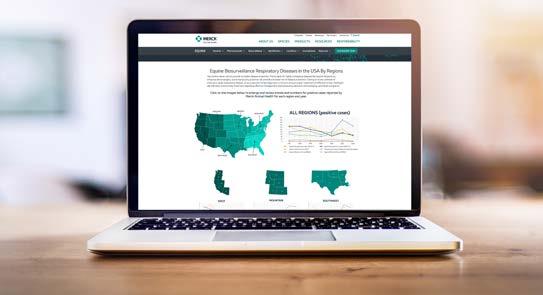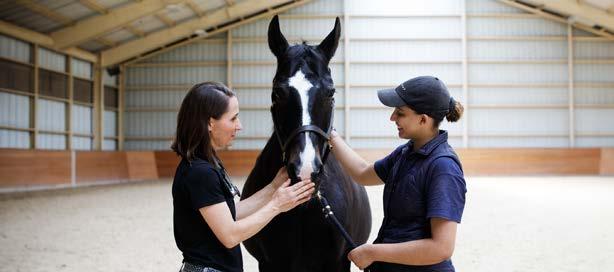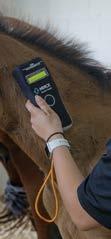Flu Season Prep: New Disease Outbreak Map, Symposium Highlights and Advanced Disease Monitoring Techniques
Flu season is right around the corner. While the virus can infect a horse anytime of year, Biosurveillance Program data continues to support a concentrated season of December to May. Now is the time to prepare your clients and their horses as the busy fall and winter season begins. In this issue we’ll highlight a new tool to help you (and your clients) track disease outbreaks across the United States. We also feature the recent International Symposium on Neglected Influenza Viruses, where Biosurveillance Program data was presented, and provide essential management practices, including how one large broodmare farm in central Kentucky is using technology to stay ahead of infectious disease (see Practice Tips).
Introducing the Equine Disease Outbreak Map
We are excited to introduce this valuable tool from the Biosurveillance Program. The interactive map provides disease occurrences across the United States, offering important insights for equine veterinarians and horse owners. Key pathogens tracked include equine influenza virus (EIV), equine herpesvirus types 1 and 4 (EHV-1, EHV-4), Streptococcus equi subspecies equi (strangles) and equine rhinitis A/B viruses (ERAV/ERBV).
Stay ahead of potential threats and enhance your disease management strategies with this essential resource. Explore the map today and share with your clients to help support informed travel decisions this fall and winter.

Equine Influenza Insights Highlighted at International Symposium
Recent findings from the U.S. Equine Biosurveillance Program were presented at the 5th International Symposium on Neglected Influenza Viruses, held April 8-10, 2024, in Lexington, Kentucky. The event brings together leading experts from around the world to discuss the critical challenges and advancements in managing influenza across all species.
The symposium’s diverse sessions covered influenza in wildlife, virus transmission and control, clinical and experimental virology, and emerging issues, offering a comprehensive view of the current state of influenza research.
Notably, the symposium featured a session dedicated to field research on surveillance and disease investigation, where recent findings from the Equine Biosurveillance Program were presented by Dr. Duane E. Chappell. Data from 5,409 nasal swab samples taken through the program from January 2017 to August 2023 were reviewed:
• 11.5% EIV infection rate
• Quarter Horses were most impacted, particularly those with a median age of 6 years and recent travel history
• Most disease cases occurred during the winter and spring
• Coughing, along with nasal and ocular discharge, were prominent clinical signs
• Horses vaccinated within the past year exhibited a significantly lower incidence of EIV, reinforcing the value of vaccination.
The Equine Biosurveillance Program continues to gain traction nationally and internationally as the largest voluntary equine infectious upper respiratory biosurveillance data set ever created, including one of the largest collections of influenza isolates. With more than 10 published research papers and frequent national and international abstract presentations, the Biosurveillance Program continues to shed light on the evolving nature of the most common infectious upper respiratory diseases of the horse.
Influenza Quick Facts
• Highly contagious with a potentially significant recovery time
• Spreads fast – a coughing horse can propel the virus more than 50 yards!
• Clinical signs appear within 24-72 hours of exposure
• Virus sheds for 7-10 days following infection
• Virus can survive 72 hours on wet surfaces and 48 hours on dry surfaces
• Indirect transmission via hands, clothing, vehicles and trailers, stalls and common-use items such as brushes, buckets and bits
For more on EIV, check out these EIV Quick Facts and share with your clients.

Current Six-Month Update
A total of 302 samples were submitted from January to June 2024. Overall, 45% of total samples submitted tested positive for one of the six primary pathogens (S. equi, EIV, EHV-4, ERBV, ERAV, EHV-1). During this timeframe, S. equi was the most prevalent upper respiratory disease reported, followed by EIV.
FIGURE 1: Disease Incidence January to June 20242
TABLE
1: Primary Demographic Parameters for the Four Major Pathogens (January–June 2024)2
FIGURE 2: Geographic Representation of the Top Four Pathogens January–June 20242
Map represents states with positive cases of S. equi, EIV, ERBV and EHV-4 during the reporting period (January-June 2024).
PRACTICE TIPS
Guest Q&A with C. Scott Bailey, DVM, MS, DACT
In this special guest contribution, we asked Dr. Bailey to share the innovative ways he’s managing infectious disease on one of Kentucky’s most prominent broodmare farms. You can also find his responses in the August issue of The Modern Equine Vet, “Ask the Infectious Disease Expert” – a special column brought to you by Merck Animal Health.
How have recent equine disease outbreaks affected your practice, and what technological advances are you seeing to help keep horses safe?
In 2021, as rotavirus B spread widely among foals in central Kentucky, we were severely affected. Without knowing the cause of diarrhea in our foals, I quickly realized that I needed a more effective monitoring tool than simply observing clinical signs like diarrhea, depression and failure to nurse. At the same time, the biosecurity challenges of having two people enter every stall and handle the foals multiple times a day for rectal temperature monitoring were significant. I realized this challenge would extend to other situations where limited handling time and personnel were preferable for biosecurity or safety reasons.
Beginning in January 2022, we started placing BioThermo® temperature-sensing microchips at the time of the initial post-foaling examination. Our staff quickly learned that the ease of using temp-sensing microchips for temperature monitoring was a substantial benefit compared to rectal temperature.
Aside from ease of use, did you or your staff notice any differences between traditional rectal thermometers and microchips?
We started out checking temps daily on those first foals and noted that some foals initially were reading higher than we expected, but quickly fell back into a more normal range. Mean temperatures measured with
the Bio-Thermo microchip in foals rose from 101.2 ± 1.1 °F at the time of microchip placement on the morning after foaling to 102.4 ± 0.57 °F on day three. They then gradually declined over 14 days in healthy foals, with a consistent standard deviation of approximately 0.6 °F. Based on these data, we have set cutoffs for further investigation at 100.5 to 103.5 °F for neonatal foals and 99.0 to 102.5 °F in foals older than 10 days. Foals with systemic disease were more likely to have high or low temperatures.
Subsequently, we compared microchip and rectal temperatures taken simultaneously in older foals and yearlings and found a remarkable degree of overlap (Figure 3). Minor variations in healthy animals didn’t affect our decision making. More importantly, we were pleased with the performance of microchips in detecting fevers in sick horses and got more confident using the scanners as a screening tool.
AAEP Issues Position on Microchips for Identification & Temperature Monitoring
In a newly issued position statement, the AAEP supports the use of radiofrequency identification devices (RFID) in horses, emphasizing the benefits of accurate traceability, regulatory compliance and health monitoring. The AAEP emphasizes the importance of ISO-compliant RFID technology for an accurate and unique identification and the inclusion of temperature-sensing microchips for efficient health monitoring. Microchips should be implanted by veterinarians or trained personnel under veterinary supervision at the mid-cervical left nuchal ligament to ensure proper functionality.
For more details, visit the AAEP website.
PRACTICE TIPS
FIGURE 3: Mean Rectal and Scanner Temperature Comparison in 46 Foals and Weanlings
Rectal Temp Scanner Temp
When taken simultaneously, mean temperatures were similar (approximately 101 °F in foals 60-300 days of age) with a similar variation (~1 °F standard deviation). On average, scanner temperatures were approximately 0.3 °F greater than rectal temperatures, with a standard deviation of approximately 1 °F.
What do you think is the best application for this technology?
For a large farm like ours, the temperature-sensing microchips allowed our farm staff to easily scan the temperatures of animals as they went out to pasture or target individual animals that appeared “off.” This method saved time and decreased the risk of injury to personnel, particularly when dealing with weaned foals and yearlings. I can see this as having wider applications in other farms, training facilities and larger boarding stables where someone might want to routinely screen animals’ health status. One additional benefit is that the scanners easily pair with software that allows dissemination of the data, so that a veterinarian or manager who is off-site could easily review and identify individual animals that may need further workup.

About the Bio-Thermo® Microchip
• Permanent identification device with a built-in temperature biosensor that measures the body temperature at the implantation site
• Provides a quick, safe and reliable method to monitor the body temperature of foals 3
• Provides a 15-digit identification number, is about the size of a grain of rice, does not need to be calibrated and will not wear out
• ISO compliant and meets FEI, USEF, The Jockey Club and many breed association requirements
Visit the Bio-Thermo Microchip web page to learn more.
Equine Respiratory Update

About the Newsletter
This biannual newsletter provides information generated through and related to the Biosurveillance Program. Driven by an Unconditional commitment to the horse and those who serve them, Merck Animal Health is providing this newsletter to veterinarians to help them stay up to date on the latest trends and historical information the study has yielded to date. Merck Animal Health Equine Veterinary Professional Services and Nicola Pusterla, DVM, PhD, DACVIM, AVDC-Equine, UC Davis, will provide technical veterinary advice, interpretation and case management support.
If you have questions about the program please call our team at (866) 349-3497, or email us at the addresses listed below. For more information and to access past issues of the newsletter, visit www.Merck-Animal-Health-USA.com.
Dr. Bryant Craig bryant.craig@merck.com
Dr. Duane E. Chappell duane.chappell@merck.com
Dr. Chrissie Schneider chrissie.schneider@merck.com
Dr. Cara Wright cara.wright@merck.com
Dr. Philip van Harreveld philip.van.harreveld@merck.com
Dr. Nicola Pusterla npusterla@ucdavis.edu
Relevant Supporting Research
For more information on the latest respiratory disease published research from Merck Animal Health, click on the links below.
1. Characterization of Equine Rhinitis B Virus Infection in Clinically Ill Horses in the United States during the Period 2012-2023 Schneider C; James K; Craig BW; Chappell DE; Vaala W; van Harreveld PD; Wright CA; Barnum S; Pusterla N. Pathogens 2023, 12, 1324. https://doi.org/10.3390/pathogens12111324
2. Voluntary Biosurveillance of Streptococcus equi Subsp. equi in Nasal Secretions of 9409 Equids with Upper Airway Infection in the USA. Jaramillo-Morales C; James K; Barnum S; Vaala W; Chappell DE; Schneider C; Craig B; Bain F; Barnett DC; Gaughan E; et al. Vet. Sci. 2023, 10, 78. https://doi.org/10.3390/vetsci10020078
3. Voluntary Surveillance Program for Equine Influenza Virus in the United States during 2008– 2021 Chappell DE; Barnett DC; James K; Craig B; Bain F; Gaughan E; Schneider C; Vaala W; Barnum SM; Pusterla N. Pathogens 2023, 12, 192. https://doi.org/10.3390/pathogens12020192
4. Voluntary Surveillance Program for Equine Influenza Virus in the United States During 2008-2021. Chappell DE; Barnett DC; James K; Craig B; Bain F; Gaughan E; Schneider C; Vaala W; Barnum SM; Pusterla N. AAEP Proceedings, 2022, Vol. 68.
5. Frequency of Detection and Prevalence Factors Associated with Common Respiratory Pathogens in Equids with Acute Onset of Fever and/or Respiratory Signs (2008-2021). Pusterla N; James K; Barnum S; Bain F; Barnett DC; Chappell DE; Gaughan E; Craig B; Schneider C; Vaala W. Pathogens 2022, 11, 759. https://doi.org/10.3390/pathogens11070759
6. Prevalence Factors Associated with Equine Influenza Virus Infection in Equids with Upper Respiratory Tract Infection from 2008 to 2019. Vaala W; Barnett DC; James K; Chappell D; Craig B; Gaughan E; Bain F; Barnum SM; Pusterla N. AAEP Proceedings. 2019 Vol 65.
7. Prevalence Factors Associated with EHV-2/5 Among Equines with Signs of Upper Respiratory Infection in the US. James K; Vaala W; Chappell D; Barnett DC; Gaughan E; Craig B; Bain F; Pusterla N. ACVIM 2017 abstract.
8. Prevalence factors associated with equine herpesvirus type 1 infection in equids with upper respiratory tract infection and/or acute onset of neurological signs from 2008 to 2014 Pusterla N; Mapes S; Akana N; Barnett DC; Mackenzie C; Gaughan E; Craig B; Chappell D; Vaala W. Vet Rec. 2015; doi: 10.1136/vr.103424.
9. Voluntary Surveillance Program for Equine Influenza Virus in the United States from 2010 to 2013 Pusterla N; Kass PH; Mapes S; Wademan C; Akana N; Barnett DC; Mackenzie C; Vaala W. J Vet Intern Med 2015; 29:417-422.
10. Surveillance programme for important equine infectious respiratory pathogens in the USA Pusterla N; Kass PH; Mapes S; Johnson C; Barnett DC; Vaala W; et. al. Vet Rec. 2011 July 2;169(1):12. doi: 0.1136/vr.d2157.
11. Voluntary surveillance program for important equine infectious respiratory pathogens in the United States Pusterla N; Kass PH: Mapes S; Johnson C; Barnett DC; Vaala W; Gutierrez C; et. al. AAEP Proceedings 2010
About the Biosurveillance Program
Since March of 2008, Merck Animal Health has been conducting an ongoing, voluntary equine biosurveillance program to study the prevalence and epidemiology of relevant viral and bacterial respiratory pathogens. More than 12,250 samples from U.S. equids of all ages, genders and breeds presenting with fever and signs of acute upper respiratory disease and/or acute neurological disease have been collected since the study began. Samples are submitted by participating Merck Animal Health customer clinics and tested via quantitative PCR at the University of California, Davis School of Veterinary Medicine (UC Davis). To be eligible for testing, horses must have an unexplained fever (T ≥ 101.5°F) AND one or more of the following signs: Lethargy, nasal discharge, cough and/or acute onset of neurologic disease. The results are returned to the Merck Animal Health customer within 24 hours of laboratory receipt of sample and provide invaluable diagnostic and treatment information.
Four-Fold Purpose:
1) To provide a valuable diagnostic tool to participating Merck Animal Health customers to assist in obtaining an accurate and timely diagnosis during an acute respiratory disease outbreak so they can provide optimal treatment, quarantine recommendations and vaccination strategies to their clients and patients.
2) To provide the horse industry with a better understanding of the prevalence and epidemiology of these respiratory pathogens
3) To identify and monitor the current circulating strains of major equine respiratory pathogens.
4) To evaluate the efficacy of current vaccination protocols.

